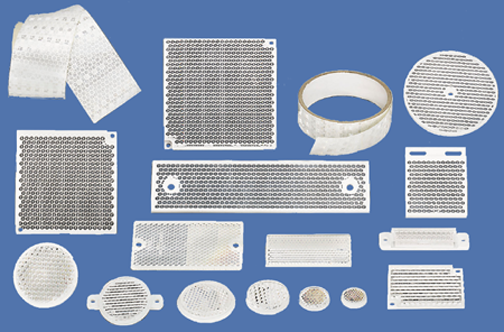Thanks to the
Sensor, Switch, Smart Camera, and Machine Vision device OEM's who've helped us compile our listing here.
Num |
A |
B |
C |
D |
E |
F |
G |
H |
I |
J |
K |
L |
M |
N |
O |
P |
Q |
R |
S |
T |
U |
V |
W |
X |
Y |
ZRadio frequency interference (RFI) - Interference caused by electromagnetic radiation at radio frequencies to sensitive electronic circuitry. RFI may originate from radio control equipment, stepper motor controls, CRTs, computers, walkie-talkies, public service communications, commercial broadcast stations, or a variety of other sources. RFI occurs most often at a specific frequency or within a specific range of frequencies. As a result, one electronic instrument may be radically affected by the presence of RF interference, while another similar instrument in the same area may appear completely immune.
Range - See Sensing range
Rate sensor - Timing logic in which overspeed or underspeed conditions are sensed by a circuit that continuously monitors and calculates the time between input signals, and compares that time with a preset reference.
Ratings Agencies Various industrialized countries have established industry groups who create guidelines and standards for machinery and components. These working groups aim to set product design standards in an effort to protect human life and capital equipment investment by defining product tests. System and methods for analyzing and classifying environments (factories, plants, and other production facilities etc.) for dangerous situations (i.e. explosive gas atmospheres) and the application of products and components to facilitate the proper selection and installation for safety reasons. See
Receiver - An electronic component, sensitive to light intensity or ultrasonic waves, that is combined with associated circuitry and output devices.
Rectifier - A device that converts alternating current into direct current. red light Visible light in the red range between 600 and 780nm. Red LEDs emit in the red-light range with a wavelength of 630 to 690nm.
Reference axis - A perpendicular axis passing through the center of the sensor face.
Reflection - The return of light striking the boundary between two media. Regular or specular reflection is reflection in which the light is returned in only one direction. If it is scattered in a number of directions, the reflection is called “diffuse.”
Reflectivity (relative) - An efficiency measurement of any material surface as a reflector of light, as compared to a Kodak white test card that is arbitrarily rated at 90% reflectivity. Relative reflectivity is of great importance in photoelectric diffuse modes where the more reflective an object is, the easier it is to sense.
Reflector - See Retro-reflector
Reflex - See Retro-reflective mode
Refraction - The “bending” of light rays as they pass through the boundary from a medium having one refractive index into a medium with a different refractive index. For example, as from air into water or from air into glass or plastic.
Registration mark - Typically a contrasting mark, printed on packaging material. This mark is used as the cutoff reference point in wrapping, bagging, and crimping applications.
Remote sensor - The optical components of a separate photoelectric sensor that are positioned separate from the power, output, and associated circuitry.
Repeat-cycle timer - Logic function where an output is cycled through specific on and specific off time durations as long as the input is present.
Repeatability - The repeat accuracy of a sensor’s operating distance measured at standardized test temperature and constant voltage.
Resistance - The opposition to the flow of electric current. That property of a material that impedes electrical current and results in the dissipation of power in the form of heat. Resistance is measured in Ohms.
Resistor - A device that restricts the flow of electrons in an electric circuit.
Response time - The time required for the output of a sensor to respond to a change of the input signal. Response time of a sensor becomes extremely important when detecting small objects moving at high speed. Narrow gaps between adjacent objects also must be considered when verifying that sensor response is fast enough for an application. Required Sensor Response Time = Apparent object (gap) size as it passes the sensor Velocity of the object as it passes the sensor. Also known as response speed. See switching frequency.
Retaining ring - Often a metal clip used to secure a shaft assembly, and or to connect two or more items together. SoftNoze use various styles of retaining rings (shown below) to assemble sensor mounts and brackets for automation sensors. For example in the spring-loaded cushioned sensor mounts, to hold a spring within the inside and outside sleeves.

Retriggerable - One of two types of one-shot timing logic. The output pulse of a retriggerable one-shot is restarted with the re-occurrence of every input. The output will remain “on” as long as the time between consecutive inputs is shorter than the one-shot pulse time.
Retroreflective sensing mode - A sensor, containing emitter and receiver, that establishes a light beam between a retroreflector and itself. An object is “sensed” when it interrupts this beam.
Retroreflector - A standard target used to return the emitted light directly back to the sensor. The most efficient type have corner-cube geometry. Reflective tapes use glass beads or smaller, less efficient corner-cubes. Some devices are attached by screws, others by an adhesive-backing. Types and shapes vary as shown here:

Reverse polarity protection - A circuit that uses a diode to avoid damage to the control in case the polarity of the power supply is accidentally reversed.
Ripple - An AC voltage component on the output of a DC power supply. The alternating component of voltage from a rectifier or generator. A slight fluctuation in the intensity of a steady current. Usually expressed as a percentage of the supply voltage. Ripple may be suppressed (“smoothed”) with capacitor filtering. Most DC-only devices require less than about 10% ripple for reliable operation.
Rise time (10% levels) - The time required for an analog voltage or current output value to rise from a low to high level.
Num | A | B | C | D | E | F | G | H | I | J | K | L | M | N | O | P | Q | R | S | T | U | V | W | X | Y | Z


